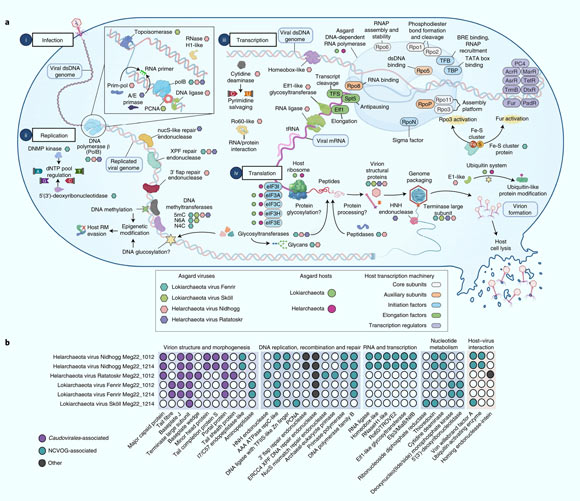Asgard archaea are globally distributed microorganisms related to eukaryotes — complex organisms including animals, plants, fungi, and amoeba. However, viruses that infect these organisms have been unknown, until now. In new research, biologists have characterized six relatively large double-stranded DNA viruses that infect two groups of Asgard archaea: Lokiarchaeota and Helarchaeota. This discovery offers tantalizing clues about the origins of complex life and suggests new directions for exploring the hypothesis that viruses were essential to the evolution of complex life.

Model of Asgard viral infection mechanisms and protein similarity with other viruses: (a) genes identified in Asgard viruses involved in infection (i), replication (ii), transcription (iii) and translation (iv); Asgard viruses are shown as different colored hexagons, Asgard hosts as different colored circles, and host transcription machinery is labeled with ovals color coded by function (see legend); (b) distribution of 35 genes (lower x axis) among Asgard viruses (y axis); filled circles indicate annotated orthologues, while white circles indicate that an orthologue was not identified. Image credit: Rambo et al., doi: 10.1038/s41564-022-01150-8.
“Our study is opening a door to better resolving the origin of eukaryotes and understanding the role of viruses in the ecology and evolution of Asgard archaea,” said Dr. Ian Rambo, a researcher in the Department of Marine Science at the University of Texas at Austin.
“There is a hypothesis that viruses may have contributed to the emergence of complex cellular life.”
“We’re referring to a hotly debated hypothesis called viral eukaryogenesis. It suggests that, in addition to bacteria and archaea, viruses might have contributed some genetic component to the development of eukaryotes.”
“This latest discovery does not settle that debate, but it does offer some interesting clues.”
Asgard archaea, which probably evolved more than 2 billion years ago, have been discovered in deep sea sediments and hot springs around the world.
To identify them, scientists collect their genetic material from the environment and then piece together their genomes.
In the new study, Dr. Rambo and colleagues analyzed hydrothermal vent-associated sediments from Guaymas Basin, 2,000 m water depth, Gulf of California.
They scanned the Asgard archaeal genomes for repeating DNA regions known as CRISPR arrays, which contain small pieces of viral DNA that can be precisely matched to viruses that previously infected these microbes.
These genetic fingerprints allowed the team to identify six viral invaders that infect currently living Asgard archaea, Lokiarchaeota and Helarchaeota.
The genomic analysis of these Asgard viruses revealed that they contain features of both prokaryotic and eukaryotic viruses.
“The most exciting thing is they are completely new types of viruses that are different from those that we’ve seen before in archaea and eukaryotes, infecting our microbial relatives,” said Dr. Brett Baker, a researcher in the Department of Marine Science and the Department of Integrative Biology at the University of Texas at Austin.
“We are now starting to understand the implication and role that viruses could have had in the eukaryogenesis puzzle,” added Dr. Valerie De Anda, a researcher in the Department of Marine Science at the University of Texas at Austin.
The paper was published in the journal Nature Microbiology.
_____
I.M. Rambo et al. 2022. Genomes of six viruses that infect Asgard archaea from deep-sea sediments. Nat Microbiol 7, 953-961; doi: 10.1038/s41564-022-01150-8







